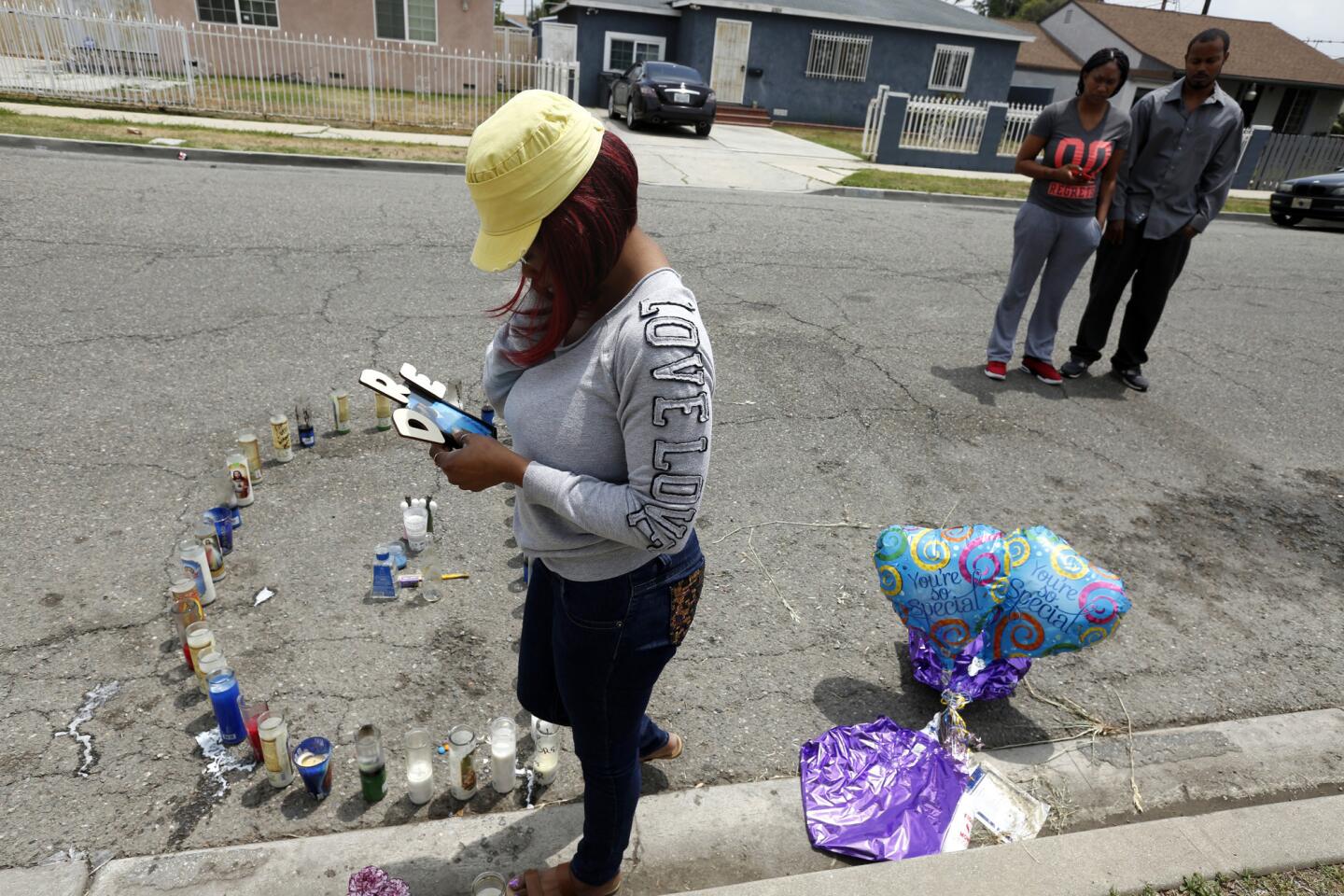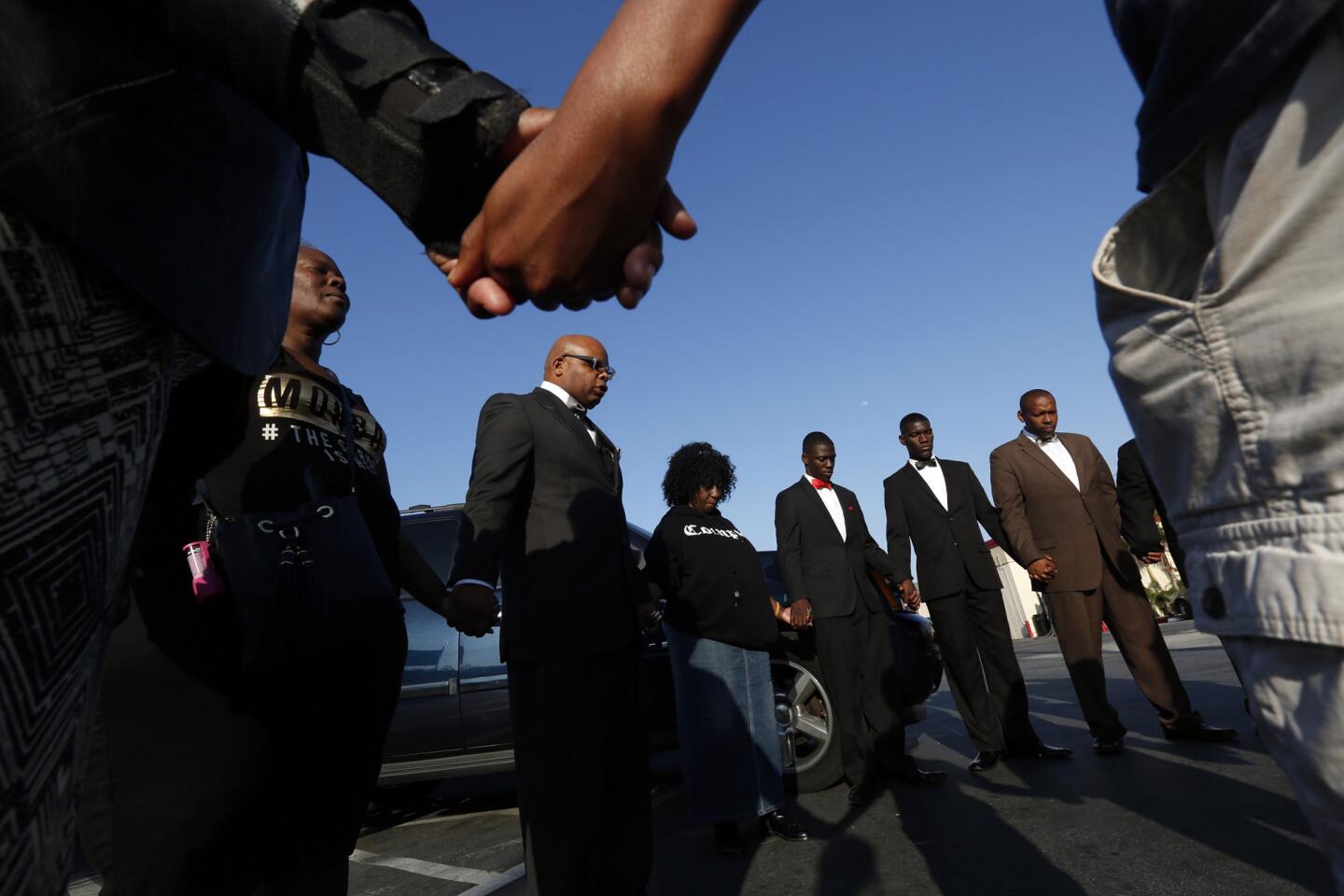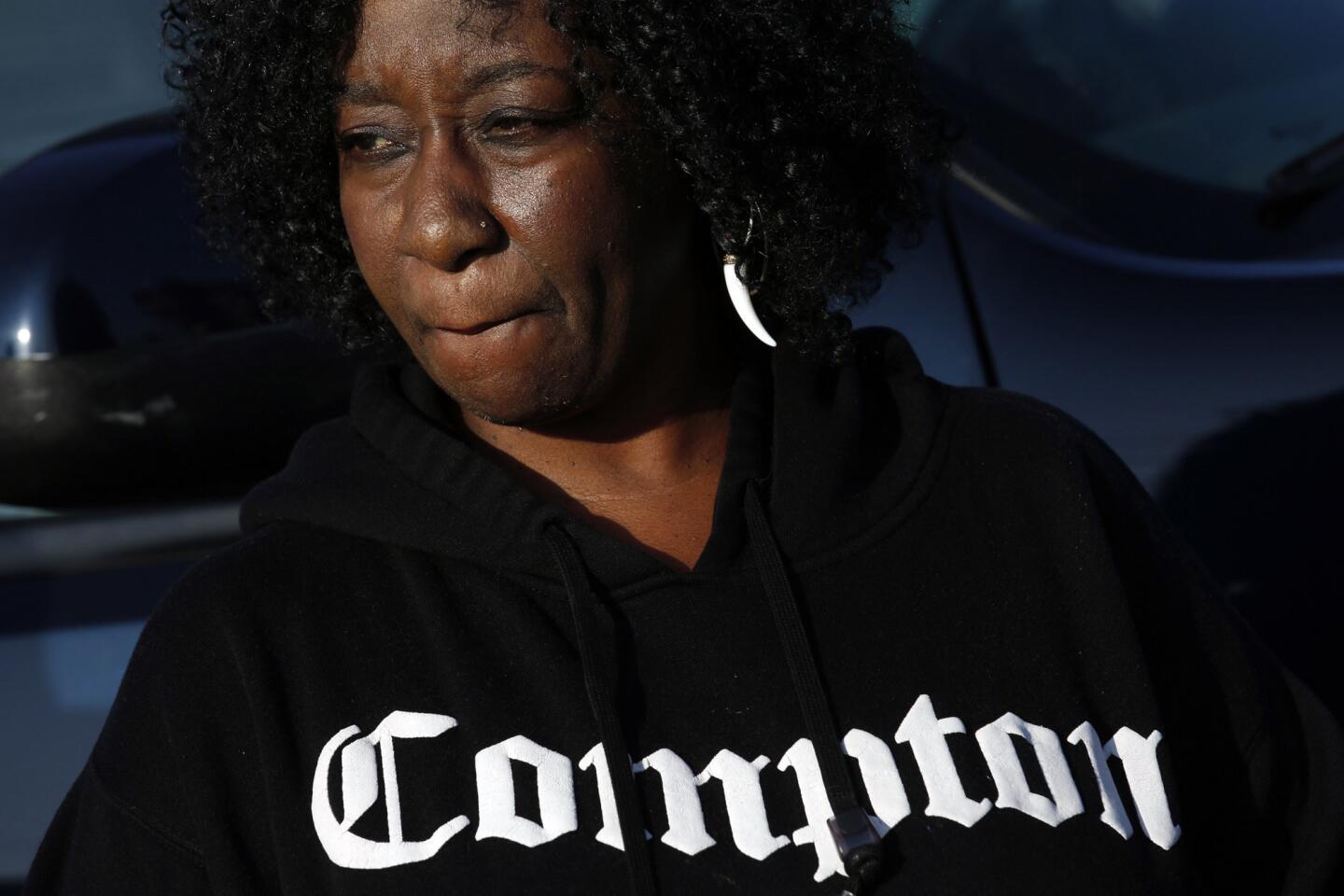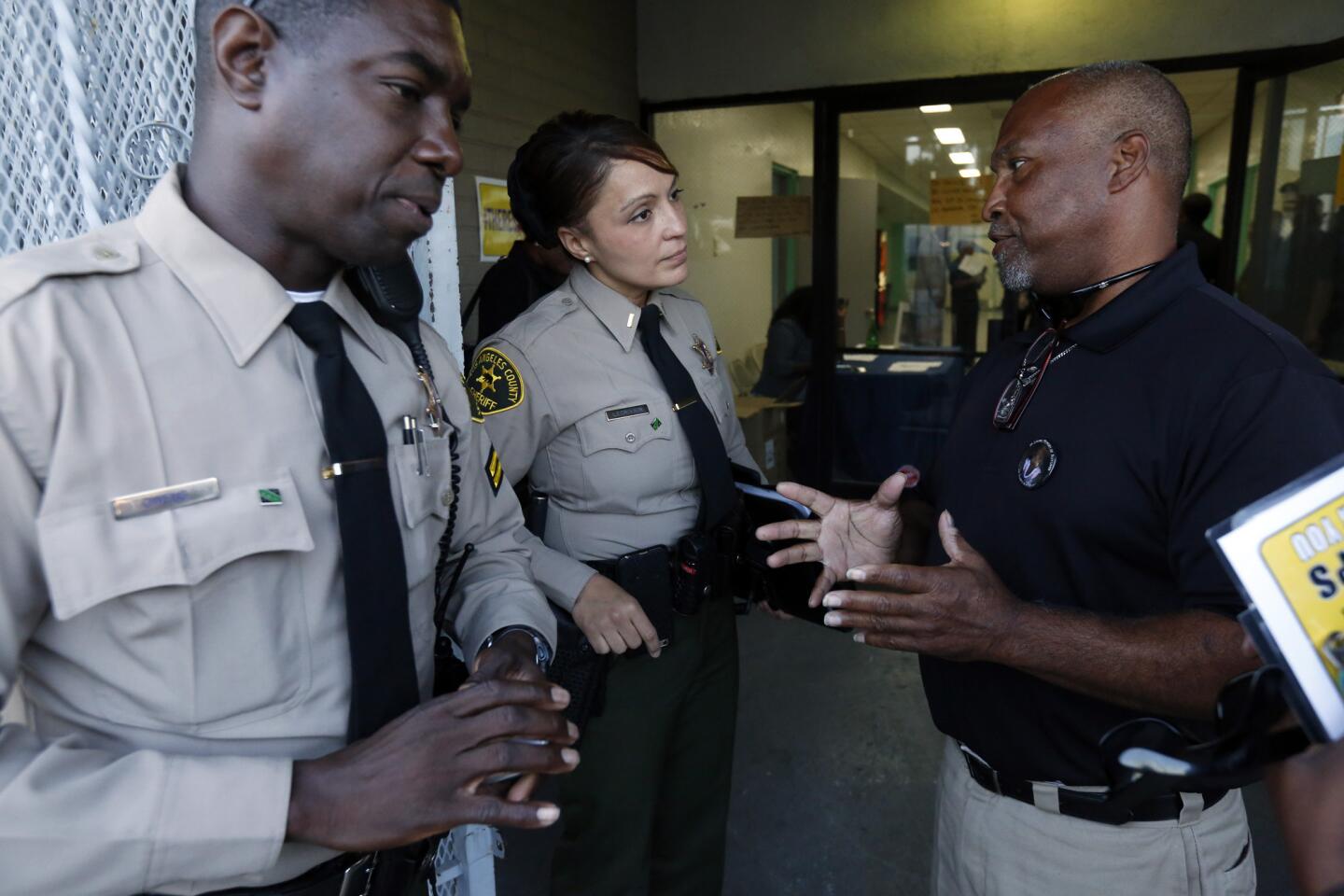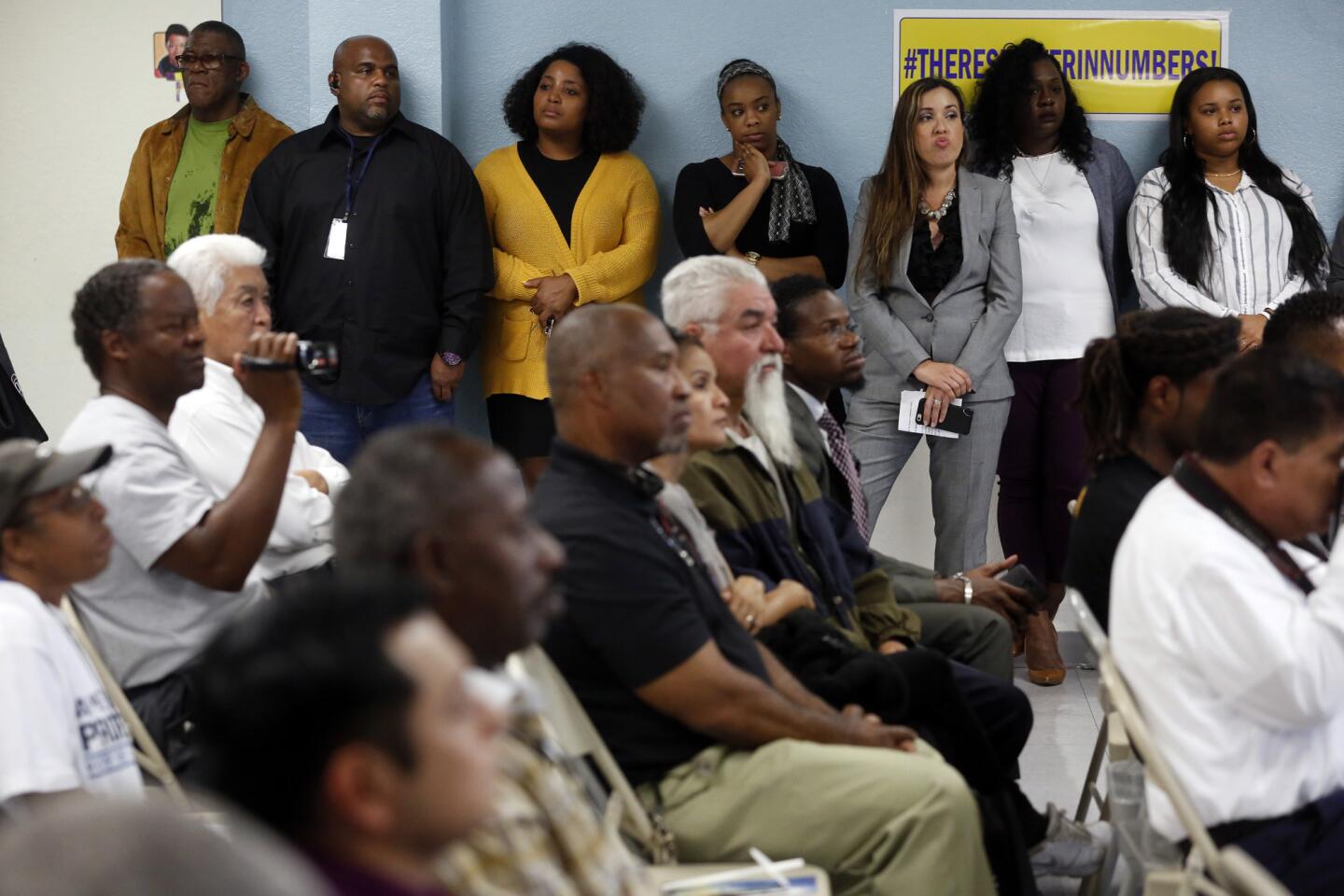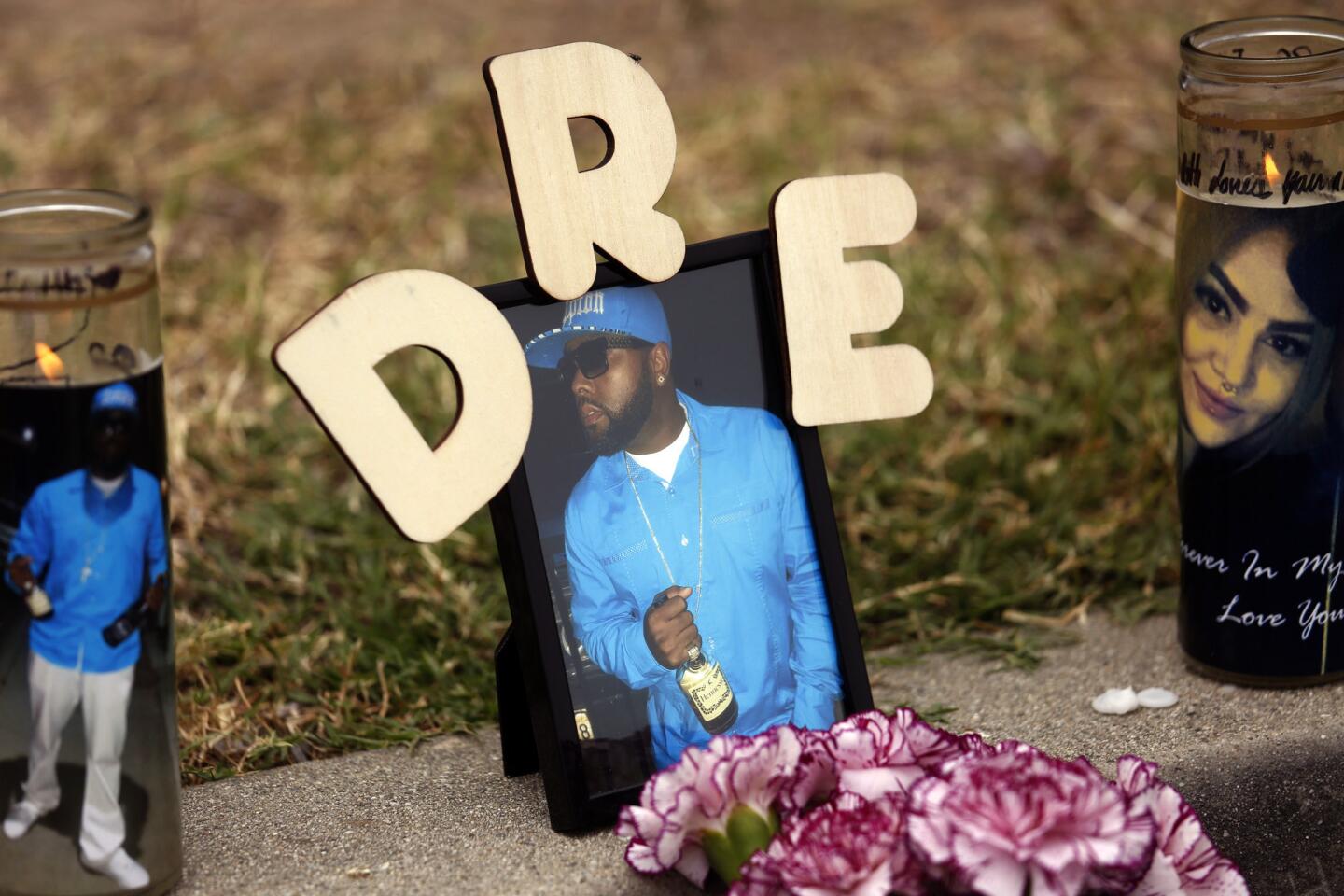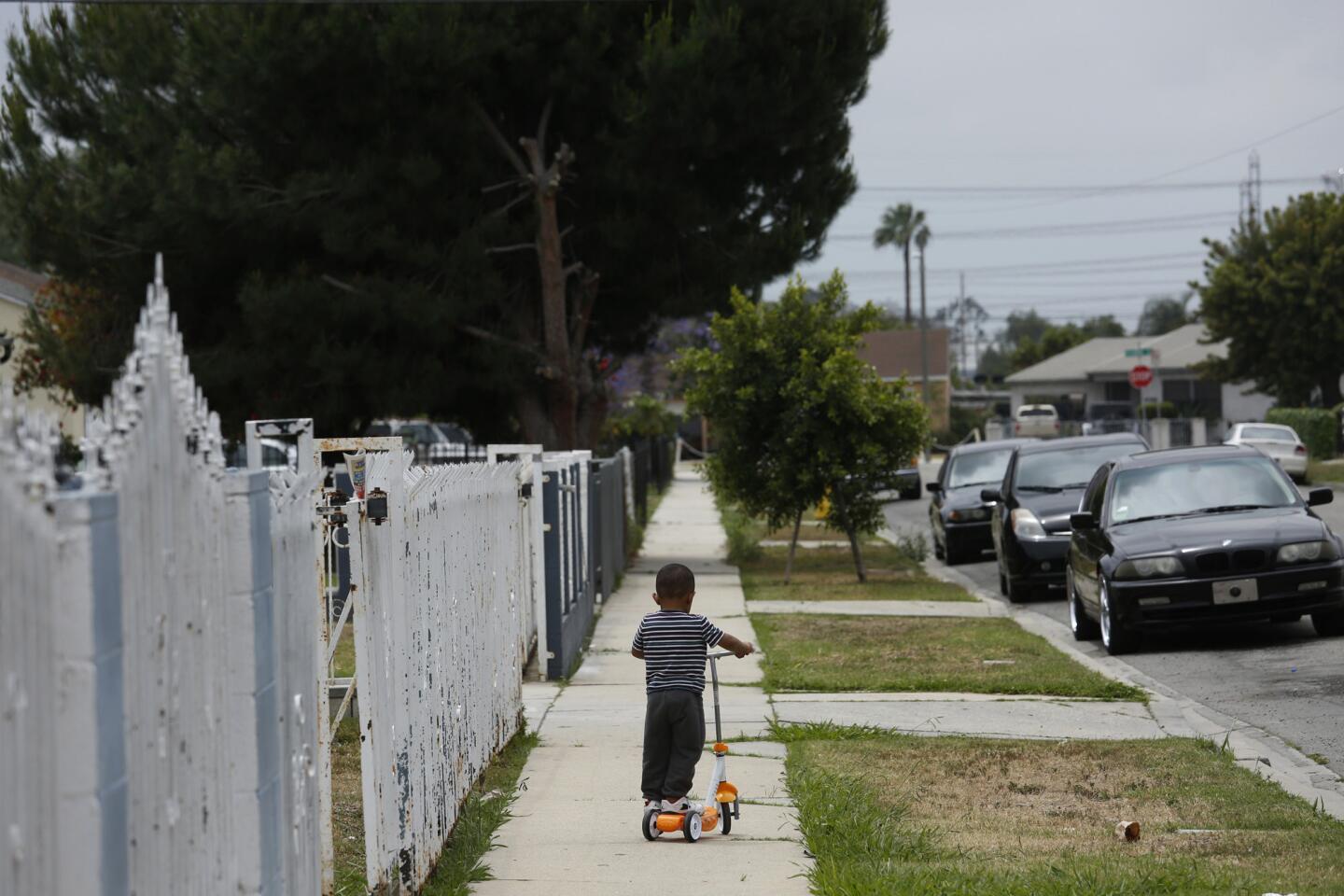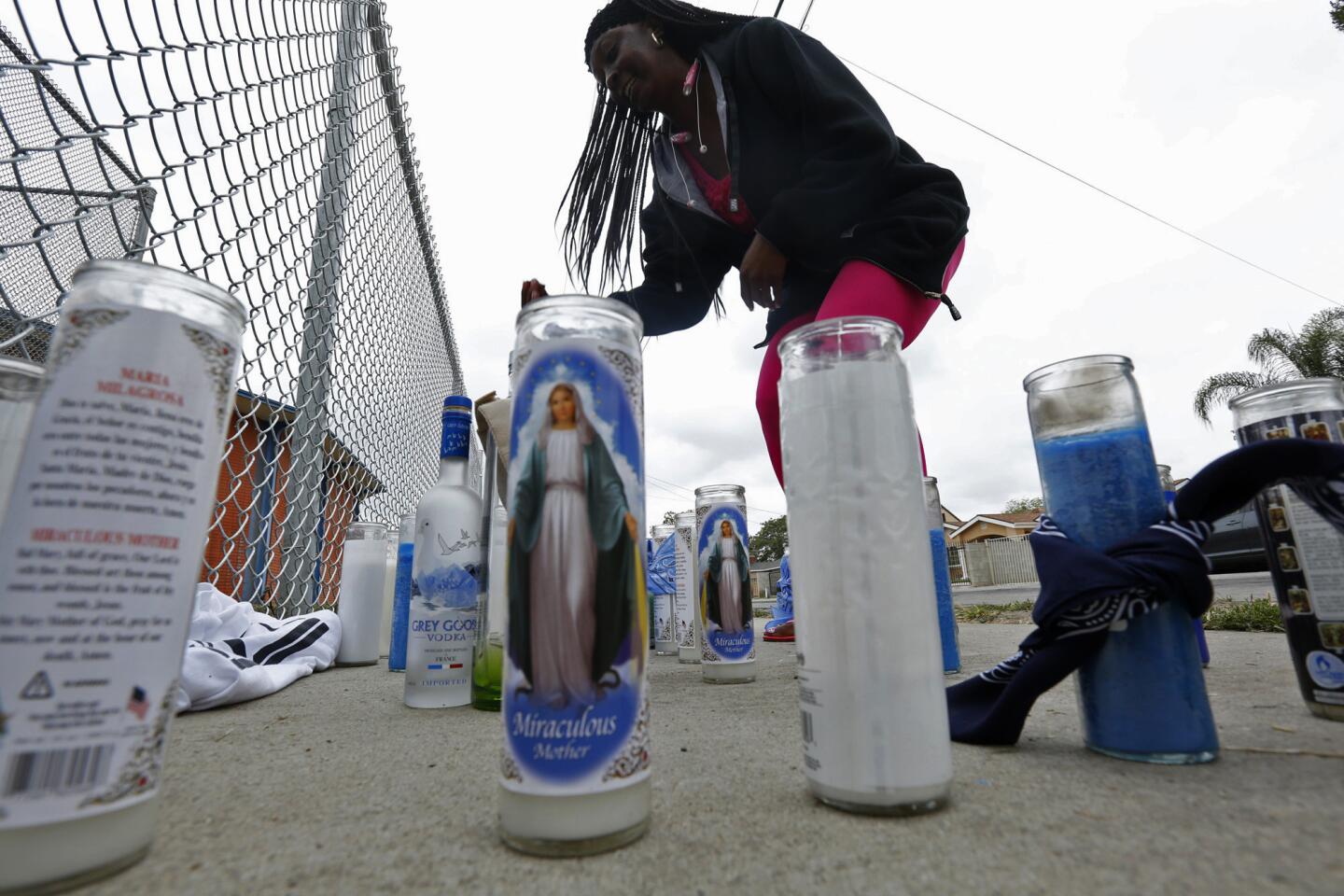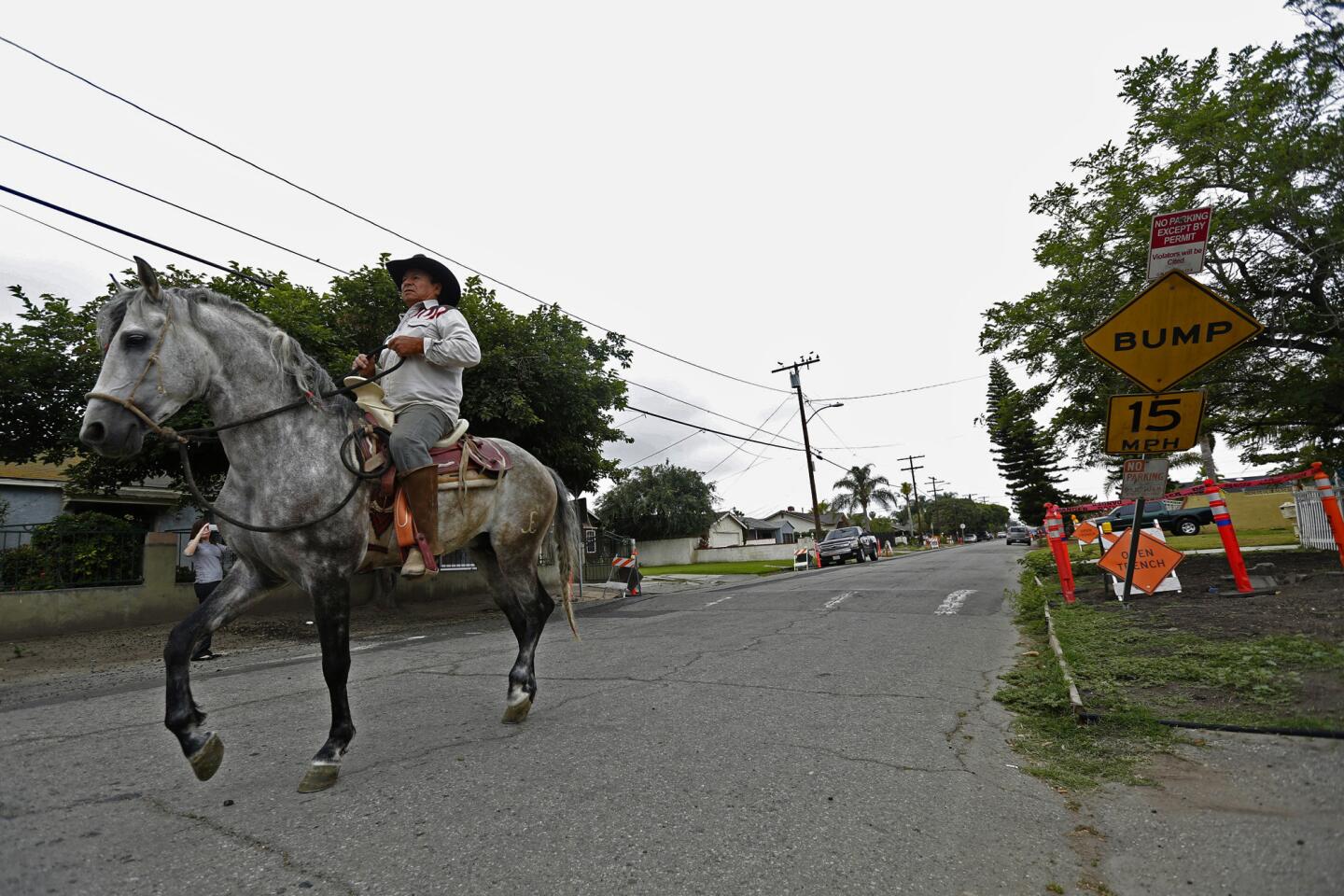Killings in Compton have tripled this year, rattling nerves and testing a key anti-crime initiative
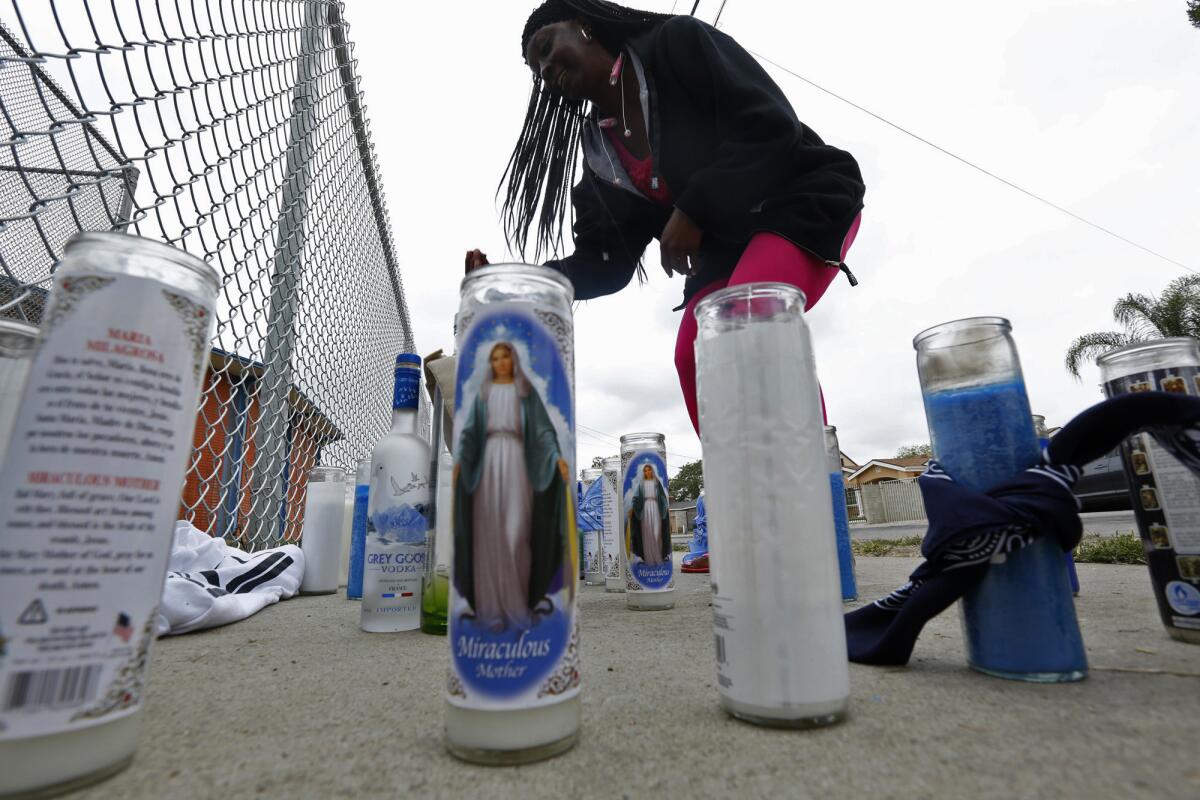
Pastor Michael Fisher had just left his Compton church when he saw a red car punctured with bullet holes.
The driver was slumped in the front seat. Another man who had been riding in the car was in the street nearby, fatally wounded and lying in his own blood.
Fisher pulled over on South Wilmington Avenue and got out to help. He looked into the pained eyes of the man on the ground and grabbed his hand. The pastor prayed as Boston Farley, a father of a 1-year-old boy, vomited, then slipped away.
“We can no longer lose our sons and daughters to senseless violence,” the pastor said later. “The community has got to stand up.”
Farley’s fatal shooting this month came amid a surge in violence in Compton. So far this year, killings have tripled compared with the same period last year, reaching 15, two more than all of 2015, according to figures from the Compton sheriff’s station. This month alone, seven people have been killed in the city of roughly 100,000 residents.
Los Angeles County sheriff’s officials say most of the killings have some sort of gang tie. In February, the city made national headlines after 1-year-old Autumn Johnson was struck and killed by gunfire as she stood in her crib. Authorities believe gang members were targeting the child’s father. But other homicides, like Farley’s, remain a mystery. Most of the killings remain unsolved.
NEWSLETTER: Get the day’s top headlines from Times Editor Davan Maharaj >>
The violence threatens to undo some of the progress the city has made in recent years to shed an image that has been associated with gangs and crime. And the shootings are testing a pledge made by federal authorities in October to help the city curb crime by providing extra resources to “make meaningful and long-lasting improvements to the daily lives of Compton residents.” At the time, the announcement of federal help was hailed as a “game-changer” by Compton Mayor Aja Brown.
At a town hall meeting last week, city and local law enforcement officials reassured anxious residents that they were doing all they could to combat the problem. The L.A. County Sheriff’s Department says it has boosted patrols. And city leaders said the federal program, the Violence Reduction Network, has already begun providing much-needed training and resources that will help deter crime.
“We want people to know that we’re looking out for you,” said Satra Zurita, a local school board member who is helping the city manage the federal program. Zurita and her sister, City Councilwoman Janna Zurita, knew the mother of one of the recent homicide victims. “It hits very close to home.”
Other cities that have been a part of the federal network have had success in reducing and solving crime. In Wilmington, Del., police created a new homicide unit and within a year, the city’s rate for solving killings tripled, federal authorities said. Last year, Detroit police reported a decline in robberies and a slight drop in homicides. So far this year, the number of killings in Oakland is down by more than 40% compared with the same period in 2015.
However, Chicago, which is also part of the network, has suffered a dramatic increase in homicides while shootings are up 50% so far this year.
In Compton, Satra Zurita said the federal partnership has helped get some “gang-bangers, pimps and young girls off the street.” The attention of multiple agencies, such as the Department of Justice, the FBI and the district attorney’s office is positive, “because you are communicating and resources match up,” she said.
Recently, the city applied for a $1-million grant from the Justice Department that would provide technology that detects and pinpoints the location of gunshots when they occur and youth intervention services over three years. In addition, Compton is working on an application for a smaller grant that would offer training for authorities who deal with those who are mentally ill.
“People think that the [federal program] comes and cures all,” Zurita said. “But what it does is provide expertise and resources, and that helps in the long run.”
The recent violence has yet to hit the levels seen more than a decade ago, when Compton recorded more than 70 killings in a single year. Since then, homicides have fallen dramatically. Last year’s tally of 13 killings was the lowest in more than a decade, according to figures provided by the Sheriff’s Department.
Sheriff’s Capt. Michael Thatcher, who heads the Compton station, said his department was taking the crime spike seriously and has deployed additional patrols, though he declined to give specifics. There are extra gang officers on the streets, sheriff’s officials said, and the city has started a public awareness campaign to urge the community to call in tips about crimes.
“It’s very troubling to us,” Thatcher said of the homicide increase.
Thatcher said it was too early to judge the effectiveness of the federal Violence Reduction Network.
In a statement, the Justice Department said the program was meant to “provide a long-term, sustainable strategy” to reduce violent crime. The department declined requests to make available people in charge of the program nationally and locally to give specifics on how the network could bolster local efforts to contain crime.
So far, Compton has received training in gang prevention from Arizona State University, learned techniques to improve community relations from the Oakland Police Department, created youth programs and formed a parolee re-entry program, city officials said.
In addition, the Justice Department said local law enforcement has received training on a number of subjects, including the use of improved technology.
An Arizona State professor is conducting research on local gangs and will provide recommendations for addressing gang violence.
“These are systemic problems that we want to address, most important, the long-term gang problem in the city,” the Justice Department said in its statement.
I don’t understand why people are going around thinking it’s OK to just shoot at people. You can’t even go to the gas station these days.
— Alaricka Hayes, sister of victim Boston Farley
Many of the killings this year have been emblematic of the city’s stubborn gang problem.
In February, Jeremiah Isaiah Dunn, 17, was visiting family for the Super Bowl when he got into a fight in a neighbor’s front yard. A rival gang member pulled out a gun and shot him, investigators said. No arrests have been made.
On May 14, Anthony Alexander was riding a bike on West Caldwell Street in Compton and reportedly “taunted” rival gang members in the area, who responded with gunfire, authorities said.
Outside Robert F. Kennedy Elementary School, near where he was shot, blue and white candles recently adorned the sidewalk, along with a blue bandanna and an empty bottle of liquor in honor of Alexander, 26. Cars slowed in curiosity as a family friend stopped to pay her respects.
“He lay right there,” said Trecie Bryant as she pointed to a dark spot in the middle of the road. Bryant, who is friends with Alexander’s mother, said the recent violence “scares the living life out of me.”
Bryant worries about her 16-year-old son, who she says likes to travel from Compton to Long Beach on the Blue Line.
“All we can do is pray and put it in God’s hands,” she said.
See the most-read stories this hour >>
Alexander’s killing remains unsolved, city officials said.
Pam Carolina, a lifelong resident of the city’s Campanella Park neighborhood, said she believes local law enforcement will have difficulty effectively combating crime because they have a poor reputation among some residents. Carolina, who works with people who have lost loved ones to violence, said she’s heard deputies swear at grieving family members.
“They’re very insensitive to families at times like this,” she said.
Farley, 23, was gunned down May 15, one of four people killed in this year’s bloodiest weekend. The man who was killed while driving Farley was Richard Williams, 24.
A sheriff’s homicide lieutenant said it is unclear why the men were targeted. Neither was a gang member, he said.
Farley, a Compton native, was working at a warehouse and planning to attend school to become a barber, said his older sister, Alaricka Hayes.
“I don’t understand why people are going around thinking it’s OK to just shoot at people,” she said. “You can’t even go to the gas station these days.”
At Thursday evening’s town hall event, a group that included city officials, activists, and Fisher, the pastor who had tended to Farley as he was dying, held more than a dozen candles, each one representing a person killed this year.
Moments later, another man addressed the crowd. When Jeffery Wandick said he was related to the 1-year-old girl who was shot to death, people in the audience gasped.
“If you got to the root of why people are being killed here, it’s probably because of nothing,” he said. “That needs to change.”
Fisher, 36, who oversees services at Greater Zion Church Family, told the crowd of nearly 100 that they couldn’t let the violence scare them into hiding.
Three days after he stood over Farley near the gas station, he returned, he said later, to confront his fears. Now, he drives through that intersection instead of finding another route.
“I know how easy it is to allow that trauma to set in,” he said. “We can’t go another way. We can’t look the other way.”
ALSO
Prince’s death casts spotlight on anti-opioid addiction drug
Candidates flood the ballot for film academy governor seats
Adrift in their own land, Afghanistan’s displaced see their population swell
More to Read
Start your day right
Sign up for Essential California for news, features and recommendations from the L.A. Times and beyond in your inbox six days a week.
You may occasionally receive promotional content from the Los Angeles Times.
